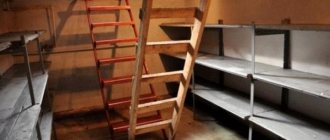Every man, without exception, has encountered repair work of varying levels of complexity at least once in his life. As for building materials, they are stocked up in advance, and in considerable quantities. There are often cases when a huge supply of a material such as cement is collected. In this case, it is necessary to take care of the safety of the expensive component over any period of time while maintaining its original qualities. In winter, construction work is carried out less frequently, and therefore the cost of materials is significantly reduced.
How to store cement in winter in a garage or other cold room
The place chosen for storing cement, regardless of how long it will be placed there, must meet a number of requirements:
- no draft;
- adequate ventilation;
- minimum temperature +5°C;
- low humidity.
Storage of cement in basements and cellars is allowed, but not recommended. This is due to the increased humidity that is present there.
Before laying containers indoors, you should check the roof for integrity. If melt water or snow gets inside the room, the cement will be damaged. Bags of cement are placed on pre-set pallets or wooden logs. It is recommended to wrap the bags with polyethylene and cover them with thick fabric after laying. Tarpaulin or thick polyethylene works best. The distance of the bags from the wall should be at least 35 cm.
Cement that is in spoiled or damaged containers cannot be stored for a long time, regardless of the location and conditions. Different brands of cement should be stored separately from each other. Otherwise, the quality of the material will deteriorate.
If a large number of bags of cement are to be stored, then laying is carried out alternately (across and lengthwise). Thus, the structure will be as stable as possible. It is allowed to construct a structure of 15 packages in height and no more than 3 m in length. There should be a regular supply of fresh air, but drafts should be completely avoided.
During the winter, the premises should be heated or the warehouse temperature maintained above zero. The quality indicator of stored materials may decrease even if all requirements are met. This will lead to an increase in material consumption by 1.5 times. Only in this way will the cement layer have optimal strength.
Arrangement of the premises
If you are going to store the bulk mixture for a longer time, you need to properly prepare the room. The bags should be placed on a special flooring. The room where the bags of cement will be located must be dry and well ventilated. If there is no ventilation, moisture will begin to accumulate in the room. To ensure the necessary ventilation, you can use the simplest forced ventilation.
The video explains how to preserve cement in winter:
You can see how walls are plastered with cement mortar in the video from the article.
When there is no ventilation in the room, two pipes can be taken outside. One should be installed 0.5 m above the floor, the other 0.5 m above the ceiling. Thanks to such measures, it will be possible to ensure excellent air movement, because it is better to spend time arranging ventilation than to later buy new cement.
In addition to arranging your premises, you must adhere to the following rules:
- You cannot store cement of different brands nearby, because they contain different amounts of moisture. Otherwise, you may degrade the quality of the cement.
- For those who plan to store the material for more than 6 months, it is necessary to wrap each bag in 2-3 layers of polyethylene. Thanks to such measures, you can additionally protect the product from moisture. Thus, it is possible to preserve the quality of cement even when stored for more than a year.
- If you store cement for a long time, then during the preparation of the solution you need to increase the consumption by 1.5 times. For example, if you take 2 kg of fresh product, then in the current situation you will need 3.5 kg.
The consumption of cement and sand for brickwork is indicated in this article.
You can store building material in winter; besides, it’s not that difficult. In this matter, it is important to know the basic nuances of storage so that all the qualities of cement are preserved. If you are confident in the manufacturer and packaging, then you can store the material in a bag for 6-8 months, but when using polyethylene you will be able to increase the shelf life. But it is best to buy material as needed, so that later you can be completely confident in its quality.
Source
Using a silo to store cement
Silos can also be used to store construction materials. It is an equipped bunker, for the manufacture of which metal is used. Externally, the silo resembles a large cylindrical building, which is equipped with an entrance for supplying stored raw materials. Inside the structure there are cleaning filters, holes for ventilation and for adjusting air humidity. Such structures are usually used on a production scale.
Cement storage silos
There are several types of silos. An example would be structures that are used when there is a small space allocated for production. Container or mobile silos are in great demand. With their help, you can transport building materials over long distances.
Advantages of the structures:
- convenience;
- high protection rate;
- ease of use;
- durability.
It is incredibly difficult to store cement at home, so it often becomes unusable after a relatively short period of time. However, even after its service life has expired, some gardeners use it to fertilize the soil. It can replace chalk or lime.
Properties of cement and its storage
Cement is a hygroscopic dry substance. Its moisture-absorbing properties are used to prepare the solution. The life of the prepared mixture is limited, then the cement turns into stone.
The activity of cement quickly decreases during long-term storage. Air humidity and carbon dioxide damage the dry mixture.
The general parameters of the safety of cement depend on its brand, ambient temperature, and date of purchase. On average, the shelf life of quick-hardening cement is no more than 45 days, other varieties - up to 60 days.
Cement cannot be kept next to paints and varnishes, alkalis, wood, metal - their proximity further reduces the short shelf life.
Shelf life of cement
The shelf life of cement will primarily depend on the humidity level in the room. The material can become damp quickly, thereby losing all its properties.
If the material in the bag has hardened, then its subsequent use is not possible.
The higher the grade of the stored material, the faster the cement will deteriorate. The 500th cement, if stored incorrectly, will turn into the 400th cement after a month. This indicator is extremely important when it comes to the quality of future concrete. More material will be needed if low grade cement is used. After a year of improper storage, the 500th cement can be used exclusively for laying tiles in the garden.
| Concrete grade | Cement M-400 | Cement M-500 | ||
| Mass composition (kg) C : P : SCH : V | Volumetric composition (kg) C : P : SH : V | Mass composition (kg) C : P : SCH : V | Volumetric composition (kg) C : P : SH : V | |
| M100 | 1 : 4,6 : 7,0 : 0,85 | 1 : 4,1 : 6,1 : 0,85 | 1 : 5,8 : 8,1 : 0,9 | 1 : 5,3 : 7,1 : 0,9 |
| M150 | 1 : 3,5 : 5,7 : 0,75 | 1 : 3,2 : 5,0 : 0,75 | 1 : 4,5 : 6,6 : 0,85 | 1 : 4,0 : 5,8 : 0,85 |
| M200 | 1 : 2,8 : 4,8 : 0,63 | 1 : 2,5 : 4,2 : 0,63 | 1 : 3,5 : 5,6 : 0,71 | 1 : 3,2 : 4,9 : 0,71 |
| M250 | 1 : 2,1 : 3,9 : 0,56 | 1 : 1,9 : 3,4 : 0,56 | 1 : 2,6 : 4,5 : 0,64 | 1 : 2,4 : 3,9 : 0,64 |
| M300 | 1 : 1,9 : 3,7 : 0,5 | 1 : 1,7 : 3,2 : 0,5 | 1 : 2,4 : 4,3 : 0,6 | 1 : 2,2 : 3,7 : 0,6 |
The packaged material has a shelf life of six months, but after this time period it will lose almost half of its original qualities. Large developers buy bulk material, which is not stored for a long time. True, no one will store it for that long, since after the material is delivered to the construction site, it is immediately used. Small production shops neglect such information.
Before purchasing the composition, it would be a good idea to look at the certificate. The distance from the pallets to the ground should be at least 35 cm. The room used needs regular and thorough ventilation. To preserve the product throughout the winter, three basic conditions must be met:
- The tightness of the container used.
- Positive room temperature.
- Low humidity level.
How to check if cement is past its expiration date
If you have stored cement for a long time, especially in winter, you will have a question about how to check its quality. First check the material in the bag. If there are hard lumps in it, then it has gone bad. If the flowability is good, test the powder by squeezing it in your palm. A high-quality powder should form into a lump, but crumble easily. You can mix a little mixture with sodium bicarbonate water in a bag and make a cake. It should set in 10 minutes. Otherwise, the material is not suitable for construction.
How to preserve cement in different conditions
Craftsmen who have purchased cement in reserve are thinking about how to properly store it until needed. In an unheated dacha, the material will be stored much better compared to rooms where frequent temperature changes occur. Creating good ventilation is paramount. Thus, you can control the humidity level in the room and eliminate drafts. Direct sunlight can damage the product and should also be avoided.
The same situation applies to storing material in the garage. An unheated garage space is much better. However, the integrity of the packaging will be of paramount importance. Regularly changing containers will only worsen the quality of the product. A room in which the temperature is at +5°C is best suited for storing cement. It is not recommended to keep the material outside.
How to store dry cement mixture
A few words about the rules for storing and storing cement
Even after purchasing high-quality cement and arriving at a construction site, you should pay attention to its storage. There are also some nuances here. Under no circumstances should bags be placed on the ground or floor. It is necessary to have pallets to ensure air circulation. If you plan to store the bags for a long time, they should be wrapped in plastic film. The top of the cement must be covered with a tarpaulin to allow ventilation. When stacking bags, you also need to remember that the height of the stack should not exceed 1.8 m. This is the only way to avoid premature hardening, and therefore damage to the building material.
Stack height no more than 1.8 m, pallet and necessarily plastic film
Stack height no more than 1.8 m, pallet and necessarily plastic film
However, today we will talk about something a little different - what to do if the cement has been lying there for a long time and has practically turned into stone. As it turned out, it does not need to be taken to a landfill. There are many options for using this building material. But it is not always possible to find reliable information on the methods of using such cement on the Internet. Therefore, the Homius editors decided to figure out which tips can be put into practice and which ones should not.
And here are the consequences of using stale building material
Conditions for storing cement in bags in winter
When storing material throughout the winter, the rules for its preservation are somewhat different from the usual ones. Exposing the material to frost should be completely avoided. The room may be heated. Low temperatures negatively affect the quality of the material, bringing it closer to its unsuitability. The optimal temperature regime used for storing cement in bags in winter is +5°C - +8°C. The higher the temperature, the lower the humidity indicator will be, which is extremely important.
Different brands of cement should not be stored nearby, since the percentage of moisture content in each brand is different. When placed close together, different grades of cement will lose some of their qualities.
Storage conditions and rules
Cement instantly absorbs water. Moisture causes the product to work—freeze. Shelf life is directly proportional to activity. At the slightest contact with water, the powder turns into dry, hard lumps. The original condition cannot be returned.
Are you using expired cement?
Not really
Conditions of detention:
- temperature above 0 degrees;
- sealed packaging;
- low humidity;
- ventilated room.
The shelf life of most brands of cement is from 3 to 6 months. M100, 200, 300 can be stored for up to a year in dry, ventilated areas at above-zero temperatures. Every month the building material loses its viscosity.
How to store cement in a cold room in winter
Any room in which you can regulate the temperature and humidity conditions is suitable for these purposes. The room should not be frozen or damp. Over time, if the room is not ventilated, the humidity will increase greatly. Regular ventilation is mandatory. Storage in a cellar, underground or basement is not recommended. Utility rooms without heating are suitable only if the temperature in them meets the indicators declared by the manufacturer. Cement is not stored in bags in cold rooms.
Main methods of storing material:
- use of containers or sealed barrels;
- pallets.
Preparatory work includes the following manipulations:
- Wooden pallets used as a base must be kept away from the ground. The indicator will be 35-50 cm. If necessary, bricks are used to adjust the height.
- Pallets are not installed close to the wall. The distance between them will be 30 cm or more.
- Opened or whole bags should be wrapped in film. Open bags are sealed with tape and secured with a stapler.
- Laying is carried out in a stack. The ranks change. The first one goes along, the second one will go across.
- The material is covered with a tarpaulin on top. One side remains open.
- The bags are turned over once every two months.
What determines the shelf life
This building material is very sensitive to environmental conditions: humidity, temperature, ventilation and therefore it is difficult to store even in untouched bags.
The main criterion for maintaining the quality of a substance is the level of air humidity, since the higher this indicator in the storage room, the faster the cement will deteriorate. For example, in just 1 month, M500 cement can turn into M400, and after a year it will literally petrify.
If quality is lost, the quality of the solution prepared from it will correspondingly deteriorate. The material consumption also increases, because the lower its characteristics, the more it is required during mixing.
The second factor influencing the shelf life of cement is the interaction of the powder with carbon dioxide in the air. For packaging, you will need dense and impenetrable bags: special construction bags or suitable-sized garbage bags. In other words, only in sealed packaging can the beneficial properties be preserved.
If storage factors are optimal, then the shelf life of Portland cement can be six months, and in cases of ideal maintenance - a year, but in practice it loses its strength and adhesive properties by about 15-20% per quarter, and if conditions are violated, even faster.
It is impossible to predict the specific timing of quality loss, therefore, after purchase, bags that need to be preserved are additionally packed in polyethylene.
But it is important to remember that during this time cement can lose up to half of its properties, so experts do not recommend buying it in reserve or in advance. If the substance was stored for a year in a completely uncomfortable environment, then it will no longer be possible to use such a mixture in construction.
How to store cement outside in winter
Almost no one succeeds in preserving material outdoors during the cold months. This is due, first of all, to the lack of stability of climatic conditions. For short-term storage, the street can be used, but the temperature outside the window should be +5°C or more.
To protect the material from wet snow you will need:
- store bags under a canopy;
- place the material exclusively on pallets;
- Cover the top with thick, water-repellent material.
If there is no canopy, a tarpaulin is used. If the weather is stable, cement can be stored for two days in such conditions.
How to store cement at home
When storing cement in bags, the period of preservation of its original properties can be significantly increased. The main task is to prevent moisture from entering the material.
In addition, the following recommendations can be given:
- The material can also be stored outdoors. However, in this case, in addition to the fact that each bag is wrapped in polyethylene, it is necessary to lay thick fabric and polyethylene on each layer.
- To avoid the penetration of moisture from the ground, the bags are placed on pallets. The height of one of them is 50 cm or more. An insulating layer (polyethylene) is installed between the wood and the bags, since the material absorbs moisture well. It is also possible to use roofing felt and galvanized metal.
- To better preserve the original characteristics, the bags should be turned over every few months.
- Each bag is wrapped in polyethylene, which avoids the penetration of dampness and moisture into the container.
You can also watch this useful video:
How long is it stored according to GOST?
This issue is regulated in accordance with GOST 30515-97 “Cements. General terms and Conditions".
When developing standards, similar European standards were taken into account, for example, the provisions of ENV 197-1.
For example, after exactly a month, Portland cement of the M-500 brand already acquires the qualities characteristic of the M-400 brand, and after a year it completely turns to stone, completely losing its suitability for further use for its intended purpose.
The brand of cement is also important. The presence of various additives in it can lead to an active reaction with carbon dioxide contained in the air.
Air promotes carbonization and dehydration, which entails a decrease in the activity of the cement composition, therefore, the adhesion index of the material decreases.
For example, a product of the M-500 brand is stored in paper bags for up to six months, however, from the moment of production, about 15% of its viscosity is lost every month.
For this reason, after 3 months you will have cement that matches the characteristics of the M400 brand instead of M500.
Manufacturers, as a rule, indicate the following shelf life, taking into account the brand of cement:
- M600 – 3 months;
- M500 – 6 months;
- M400 – 6 months;
- M300 – 12 months;
- M200 – 12 months;
- M100 – 12 months.
After opening the package, in accordance with GOST 30515-97, quick-setting cement grades (M-400 - M-600) can retain their consumer qualities for up to 45 days, and normal-setting cement grades (M-100 - M-300) - up to 60 days.
After the specified time, the building material is a priori unfit for further use, since there is no guarantee of the durability of the concrete solution based on such material.
It is commercially justified to package cement in bags of 25, 40 and 50 kg.
According to GOST 30515-97, the gross weight of cement containers should not be more than 51 kg. This packaging guarantees less caking and simplifies the transportation of building materials.
How to preserve cement at your dacha in winter
Based on current state standards, the best containers for storing cement are paper bags. Their capacity can be 25, 40 and 50 kg. The paper will absorb unnecessary moisture, preventing the material from becoming damp and becoming less durable. To achieve optimal protection, manufacturers often alternate polyethylene with paper, which helps achieve a lamination effect. Paper, in turn, can be impregnated and bitumenized. In this way, the shelf life of cement can be extended even if the packaging is opened.
The shelf life of the material is short, so after opening it should not be stored in this form for a long time. If, after completion of repair work or in case of a forced break, there are open packages of cement left, then any sealed container, such as wooden barrels, should be used. The clips will help seal the package tightly by squeezing out excess air from the bag. After placing cement in a barrel, it is covered with sand. The barrel is closed with a lid and then wrapped in polyethylene. In this way, the shelf life of cement can be extended by a month.
How long do different brands last?
The difficulty in storing cement lies in the fact that this material has increased moisture-absorbing properties. It actively absorbs moisture from the environment and reacts with carbon dioxide, which negatively affects the strength characteristics of the final solution.
Each batch of cement is tested for strength under production conditions, which allows the material to be marked in increments of 100. The lowest grade of building material is designated M100 - it provides the least durable composition. M600 has the highest strength characteristics. High grade cements are more demanding on storage conditions and have a shorter shelf life.
Cement storage rules
Leaving cement in the open air is not recommended. Even during the process of mixing cement mortar, all manipulations should be carried out under a canopy. The room chosen for storage should be well ventilated, warm and dry. In a closed room, moisture and carbon dioxide quickly accumulate, which negatively affect the material. Negative temperatures can also speed up the process of cement deterioration. Experts do not recommend using basements, since this is where the greatest amount of moisture accumulates.
Warehouses and attics must be heated or warm. The manufacturer claims that the material can be stored throughout the winter provided that the temperature is +5°C and above. In the absence of natural ventilation, ventilation is carried out independently. There are also several rules for placing bags. Bags are not laid on film or bare ground. Care should be taken to have a ventilated tray. A durable tarpaulin or several layers of polyethylene are placed on top of the bags. It should not be completely sealed.
For ventilation, leave one side open, which is towards the flow of fresh air. When using bulk cement, it is possible to use several storage methods: placing the mixture in a sealed barrel or subsequent packaging in special bags. The storage containers used have a volume of over 200 liters. Equipped with special latches. Plastic or wood is used to make containers.
How to store cement in bags in winter: in the garage, at the dacha, at home, on the street
Construction material cement
Arrangement of the premises
If you are going to store the bulk mixture for a longer time, you need to properly prepare the room. The bags should be placed on a special flooring. The room where the bags of cement will be located must be dry and well ventilated. If there is no ventilation, moisture will begin to accumulate in the room. To ensure the necessary ventilation, you can use the simplest forced ventilation.
The video explains how to preserve cement in winter:
You can see how walls are plastered with cement mortar in the video from the article.
When there is no ventilation in the room, two pipes can be taken outside. One should be installed 0.5 m above the floor, the other 0.5 m above the ceiling. Thanks to such measures, it will be possible to ensure excellent air movement, because it is better to spend time arranging ventilation than to later buy new cement.
In addition to arranging your premises, you must adhere to the following rules:
- You cannot store cement of different brands nearby, because they contain different amounts of moisture. Otherwise, you may degrade the quality of the cement.
- For those who plan to store the material for more than 6 months, it is necessary to wrap each bag in 2-3 layers of polyethylene. Thanks to such measures, you can additionally protect the product from moisture. Thus, it is possible to preserve the quality of cement even when stored for more than a year.
- If you store cement for a long time, then during the preparation of the solution you need to increase the consumption by 1.5 times. For example, if you take 2 kg of fresh product, then in the current situation you will need 3.5 kg.
The consumption of cement and sand for brickwork is indicated in this article.
You can store building material in winter; besides, it’s not that difficult. In this matter, it is important to know the basic nuances of storage so that all the qualities of cement are preserved. If you are confident in the manufacturer and packaging, then you can store the material in a bag for 6-8 months, but when using polyethylene you will be able to increase the shelf life. But it is best to buy material as needed, so that later you can be completely confident in its quality.
In room
At home, cement is usually stored in the garage. If it is a dry and well-ventilated room, it can be used to contain the composition. But, you cannot keep the mixture in a damp garage; due to moisture, it will quickly lose its properties. You can also use a dry storage room or any other room that meets the following requirements:
- Low humidity.
- The optimal temperature is from +5°C.
- Effective ventilation.
The material must not be placed on the floor. First, closed paper bags are wrapped in several layers of plastic film and then placed on wooden pallets or racks. The top of the bags must be covered with film or tarpaulin. Those sides through which ventilation air flows should be left open.
There should be a distance of at least 30 cm between the floor and the first bag. A similar distance should be between the pallets and the walls. It is advisable to put batches by brand, without mixing them with each other. If the material will be stored for a long time, the bags must be turned over every 2 months to prevent the mixture from caking.
The temperature in the warehouse should be +5 ˚С and above. A dry, ventilated, draft-free room is suitable for storage. To prevent contact with moisture, the container is additionally packed with polyethylene except for the sides directed towards the air flow.
Important: cement cannot be stored in an open area in winter. Cold and damp will turn him to stone. Use polyethylene!











